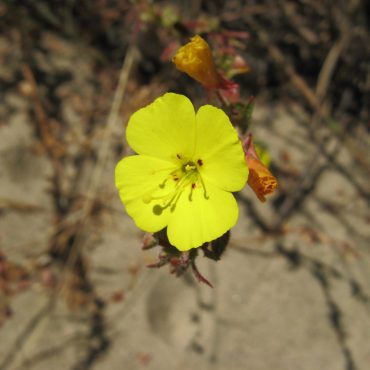California sun cup (Camissoniopsis bistorta) is a low-growing native annual in the evening primrose family. Most of the year it is an inconspicuous presence in open spots along the trails, making one wonder about its cheerful name. However, after winter rains, this plant produces numerous, small, bright yellow flowers, often with a ring of dark red spots in the center. Together with the bright “kernels” of popcorn flower, these transform dry sandy spots into bursts of sunny color.
California Sun Cup
Camissoniopsis bistorta

Other Common Names:
suncups, sun cup, southern sun cup, southern suncup
Description 2,4,11,23,26,34,59
California sun cup is a low-growing annual plant. A basal rosette often produces one or more sprawling reddish stems to 32 inches (80 cm) in length. Stems and leaves are more or less covered with long hairs. Leaves are linear to lanceolate or oblanceolate, occasionally narrowly elliptic, to five inches (12 cm) in length. The basal leaves are carried on short petioles; the cauline leaves tend to clasp the stem. The leaf margins are often wavy with small teeth and may turn reddish.
The bisexual flowers occur in leaf axils near the ends of the branches. There are four sepals and four petals. The sepals bend back sharply when the flower opens, sometimes remaining united into pairs by their tips. Flowers are usually less than one inch (2.5 cm) across and may be much smaller.There are four rounded bright yellow petals that often have one or two dark red spots near the base. After pollination, petals curl neatly and become tinged with orange before falling. There are eight stamens, four shorter than the others. The yellow anthers are elongate and often curved. The pistil has an inferior ovary with a long style and prominent spherical stigma that extends beyond the stamens. California sun cup has a long bloom period, centered on March – July.1
The fruit is an elongated four-chambered capsule that splits open from one end. The capsule is more square than round in cross-section and curls and coils as it matures. The opened capsule has an artistic flower shape.
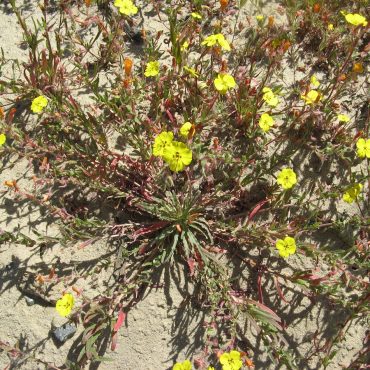

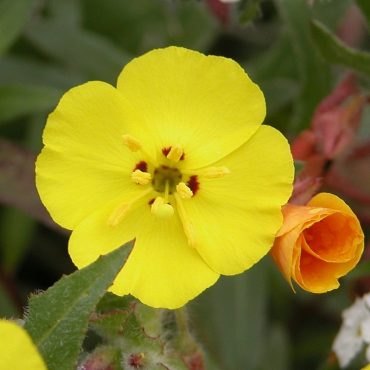
Distribution 7,89
California sun cup is native to coastal southern California, primarily from Point Conception south into Baja California and from the Peninsular ranges west. It grows mostly below 4000 feet (1200 m).89 It prefers sandy openings in a variety of natural and disturbed habitats.
In the Reserve, California sun cup is frequently seen in openings along the south side trails and on Stonebridge mesa; it often grows with popcorn flower (Cryptantha spp.).
Learn more about plant vegetation types here
Classification 2,11,44,59,143
California sun cup is a dicot angiosperm, which is a member of the evening primrose family (Onagraceae). Plants in the evening primrose family are characterized by radial, bisexual flowers with parts in multiples of four, often four petals, four sepals and eight stamens. Other members of this family found in the Reserve include the delicate canyon clarkia (Clarkia epilobioides), the robust Hooker’s evening primrose (Oenothera elata ssp. hirsutissima) and the closely related beach primrose (Camissoniopsis cheiranthifolia ssp. suffruticosa),48 with which it may intergrade.
California sun cup was originally placed in the genus Oenothera. Along with several other species, they were moved into a new genus, Camissonia, on the basis of the structure of the stigma, which is spherical in Camissonia and X-shaped in Oenothera, and also by the fact that flowers of Camissonia open in daytime, rather than evening.59 Recently Camissonia was further split and California sun cup was moved to Camissoniopsis.
Alternate Scientific Names:
Camissonia bistorta, Oenothera bistorta, Oenothera heterophylla
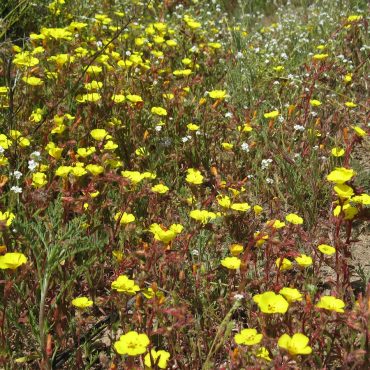
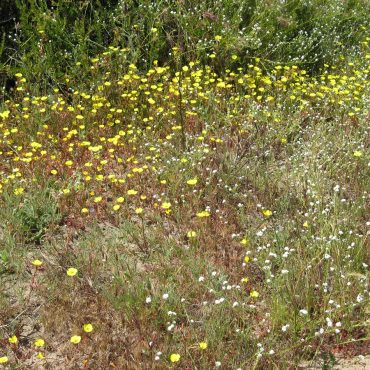
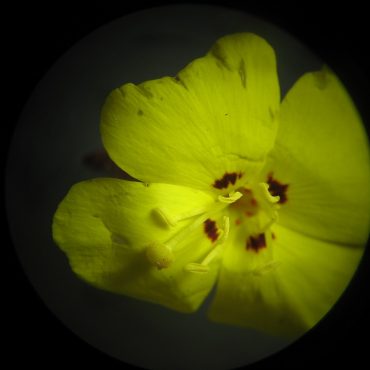
Ecology
The evening primrose family is large and exhibits diverse pollination strategies, Some, such as Hooker’s evening primrose (Oenothera elata) are pollinated at night. Others, such as beach primrose (Camissoniopsis cheiranthifolia) are day bloomers.Some are largely cross-pollinated; others, including beach primrose, have both self-pollinated and cross-pollinated populations. The pollen of some species have viscin threads and collection requires specialized manipulation and restrict possible pollinators.41 The family has become something of a lab rat for studies on the relationship between speciation and pollination.163,164,328
California sun cup is a day-bloomer that is primarily cross-pollinated. A spatial separation of stigma and stamens is a common mechanism for restricting self-pollination.328 In California sun cup this is accomplished by the position of the stigma beyond the anthers. Unfortunately, California sun cup has not been specifically studied, so its most interesting adaptations remain to be discovered.
Recently, it has been shown that one species of evening primrose (Oenothera drummondii) can detect the high frequency vibration of a bee – it hears it!471,472 The open bowl shape of the typical evening primrose flower is similar to that of a radar receptor or satellite dish and may be the flower’s adaptation for “hearing.” The primrose responds by temporarily increasing the sweetness of its nectar, and it is postulated that this may attract more pollinators. We are watching the birth of an entirely new field of plant ecology: phytoacoustics.
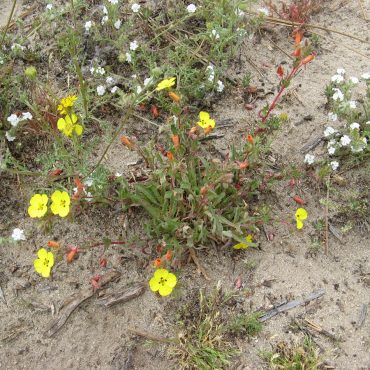
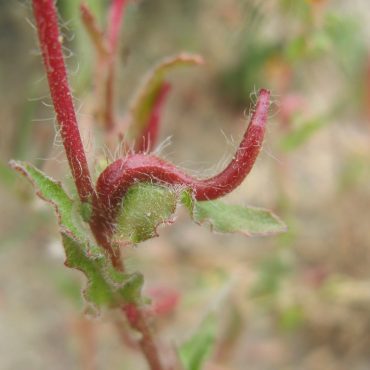
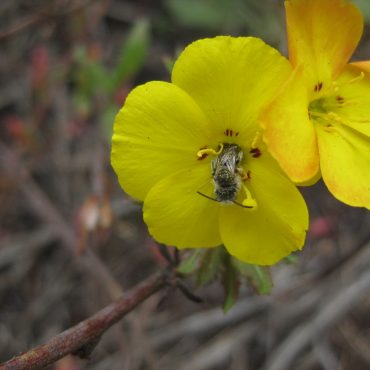
Human Uses
As yet, we have found no reports of Native American use of California sun cups. We have found two references to the use of the foliage of related species (Camissonia spp.) for food; one report involved the Castanoan Indians of the Central California coast and one the Cahuilla Indians of the Coachella Valley.282
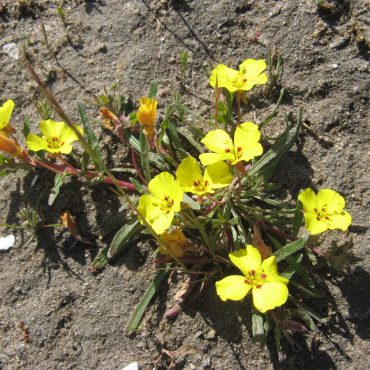
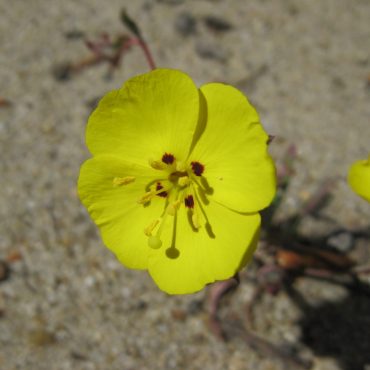
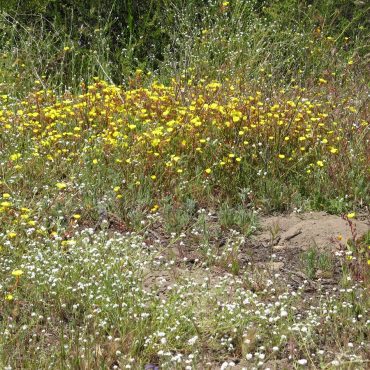
Interesting Facts
All living organisms are given a unique Latin name. Birds, in addition, have only one common name for each species – and a single species per common name. These are established by the American Ornithologists’ Union.41 However, plant common names are not controlled. Through the generations, a flower may acquire many common names and several flowers may end up with the same common name. If one searches for the name “sun cup” one finds at least 30 species carrying “sun cup” as part or all of their name7 – and one allergen-friendly chocolate candy.41
